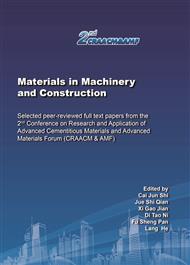[1]
S.K. Chattopadhyay, R.K. Khandal, R. Uppaluri, et al, Bamboo fiber reinforced polypropylene composites and their mechanical, thermal, and morphological properties, J. Appl. Polym. Sci. 119 (2011) 1619-1626.
DOI: 10.1002/app.32826
Google Scholar
[2]
A. Elkhaoulani, F.Z. Arrakhiz, K. Benmoussa, et al, Mechanical and thermal properties of polymer composite based on natural fibers: Moroccan hemp fibers/polypropylene, Mater. Des. 49 (2013) 203-208.
DOI: 10.1016/j.matdes.2013.01.063
Google Scholar
[3]
M.R. Ismail, A.A.M. Yassen, M.S. Afify, Mechanical properties of rice straw fiber-reinforced polymer composites, Fibers. Polym. 12 (2011) 648-656.
DOI: 10.1007/s12221-011-0648-5
Google Scholar
[4]
F. Vilaseca, R. Del Rey, R. Serrat, et al, Macro and micro-mechanics behavior of stifness in alkaline treated hemp core fibres polypropylene-based composites, Compos. B. Eng. 144 (2018) 118-125.
DOI: 10.1016/j.compositesb.2018.02.029
Google Scholar
[5]
F. Yao, Q. Wu, Y. Lei, et al, Rice straw fiber-reinforced high-density polyethylene composite: Effect of fiber type and loading, Ind. Crops. Prod. 28 (2008) 63-72.
DOI: 10.1016/j.indcrop.2008.01.007
Google Scholar
[6]
H.S. Yang, D.J. Kim, H.J. Kim, Rice straw-wood particle composite for sound absorbing wooden construction materials, Bioresour. Technol. 86 (2003) 117-121.
DOI: 10.1016/s0960-8524(02)00163-3
Google Scholar
[7]
X.D. Zhu, F.H. Wang, Y. Liu, Properties of wheat-straw boards with FRW based on interface treatment, Phys. Procedia. 32 (2012) 430-443.
DOI: 10.1016/j.phpro.2012.03.582
Google Scholar
[8]
A. Satlewal, R. Agrawal, S. Bhagia, et al, Rice straw as a feedstock for biofuels: Availability, recalcitrance, and chemical properties, Biofuel. Bioprod. Biorefin. 12 (2017) 83-107.
DOI: 10.1002/bbb.1818
Google Scholar
[9]
B. Tsegaye, C. Balomajumder, P. Roy, Organosolv pretreatments of rice straw followed by microbial hydrolysis for efficient biofuel production, Renew. Energ. 148 (2020) 923-934.
DOI: 10.1016/j.renene.2019.10.176
Google Scholar
[10]
M. Tejada, C. Benitez, Effects of crushed maize straw residues on soil biological properties and soil restoration, Land. Degrad. Dev. 25 (2014) 501-509.
DOI: 10.1002/ldr.2316
Google Scholar
[11]
X. Zeng, Y. Ma, L. Ma, Utilization of straw in biomass energy in China, Renew. Sust. Energ. Rev. 11 (2007) 976-987.
DOI: 10.1016/j.rser.2005.10.003
Google Scholar
[12]
J. George, M.S. Sreekala, S. Thomas, A review on interface modification and characterization of natural fiber reinforced plastic composites, Polym. Eng. Sci. 41 (2001) 1471-1485.
DOI: 10.1002/pen.10846
Google Scholar
[13]
L.J. Qin, J.H. Qiu, M.Z. Liu, et al, Mechanical and thermal properties of poly(lactic acid) composites with rice straw fiber modified by poly(butyl acrylate), Chem. Eng. J. 166 (2011) 772-778.
DOI: 10.1016/j.cej.2010.11.039
Google Scholar
[14]
N.D. Yaacab, H. Ismail, S.S. Ting, Potential use of paddy straw as filler in poly lactic acid/paddy straw powder biocomposite: thermal and thermal properties, Procedia. Chem. 19 (2016) 757-762.
DOI: 10.1016/j.proche.2016.03.081
Google Scholar
[15]
Y. Zhao, J.H. Qiu, H.X. Feng, et al , Improvement of tensile and thermal properties of poly(lactic acid) composites with admicellar-treated rice straw fiber, Chem. Eng. J. 173 (2011) 659-666.
DOI: 10.1016/j.cej.2011.07.076
Google Scholar
[16]
K. Oksman, M. Skrifvars, J.F. Selin, Natural fibres as reinforcement in polylactic acid (PLA) composites, Compos. Sci. Technol. 63 (2003) 1317-1324.
DOI: 10.1016/s0266-3538(03)00103-9
Google Scholar
[17]
K.F. Kelton, A.L. Greer, Nucleation in condensed matter: applications in materials and biology, Pergamon, London, (2010).
DOI: 10.1016/s1470-1804(09)01506-5
Google Scholar
[18]
Y.H. Zhang, L. Yang, Y.F. Zuo, et al, Effect of glycerol addition on the properties of wood flour/polylactic acid composite, J. Build. Mater. 18 (2015) 1111-1116.
Google Scholar


